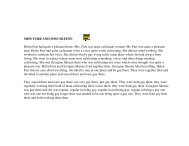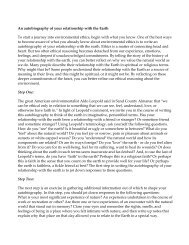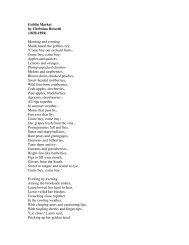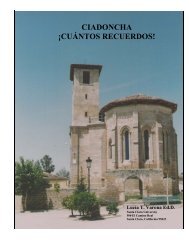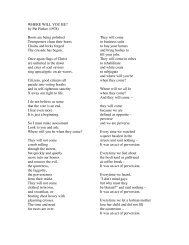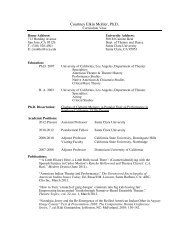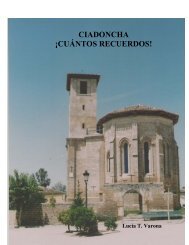ciadoncha; ¡cuántos recuerdos - Webpages at SCU - Santa Clara ...
ciadoncha; ¡cuántos recuerdos - Webpages at SCU - Santa Clara ...
ciadoncha; ¡cuántos recuerdos - Webpages at SCU - Santa Clara ...
You also want an ePaper? Increase the reach of your titles
YUMPU automatically turns print PDFs into web optimized ePapers that Google loves.
One participant commented how <strong>at</strong> one time, onion soup was e<strong>at</strong>en morning,<br />
afternoon, and night in Ciadoncha. Today, all the restaurants offer this dish as a special.<br />
He smiled and told me- “Before, onion soup was food for the poor”- He l<strong>at</strong>er told me<br />
th<strong>at</strong> in those times, if someone came to the door and the family was e<strong>at</strong>ing onion soup,<br />
they would hide it. I think the same happened with nut-brittle. This was the food th<strong>at</strong> the<br />
pastors took to the field. At one point, it was seen as less by everyone else, but today we<br />
pay wh<strong>at</strong>ever for a good piece of nut-brittle, either hard or soft.<br />
In the magazine we found an article about the prepar<strong>at</strong>ion of bread. In it, some<br />
people explained how and when this work was done. It involved kneading and kneading,<br />
<strong>at</strong> least for one hour. The dough, which was made of sifted flour, salt, w<strong>at</strong>er and yeast,<br />
had to get hard enough. Then, a cross was made in the dough and it was covered with a<br />
cloak for about two hours, until it rose. Then it had to bake. In those times, all the<br />
houses did not have ovens, unlike today with all the modern stoves. There were several<br />
ovens, but back then they were very expensive so they had to ask for a turn. Sometimes<br />
they had to get up very early because they baked twice, in the morning and in the<br />
afternoon.<br />
They he<strong>at</strong>ed the oven with straw or firewood, throwing it in handfuls or bent<br />
down on their knees. When the oven turned white, the inside was cleaned out and the<br />
bread was placed inside. First the oil tarts and then the large loafs. They baked for 15<br />
days. Sometimes the bread would get moldy and they would have to e<strong>at</strong> it, taking off the<br />
worst parts. They stored the bread in a room, in a corner –“It smelled so good when we<br />
passed by”- commented the narr<strong>at</strong>or (10).<br />
In Ciadoncha, wh<strong>at</strong>ever is e<strong>at</strong>en is wh<strong>at</strong> has been prepared <strong>at</strong> home th<strong>at</strong> day. For<br />
many years, refriger<strong>at</strong>ors were maintained empty. First because it was not customary to<br />
store food from one day to the next. Then, since they had lived without one for so many<br />
years they had developed other methods of conserv<strong>at</strong>ion and were not in need of the<br />
modern refriger<strong>at</strong>or. Today we see more than anything th<strong>at</strong> the freezer is kept full of<br />
me<strong>at</strong> from the sacrifice and of products from the orchard.<br />
A typical breakfast in Ciadoncha.<br />
Photo Lucía Varona<br />
67



